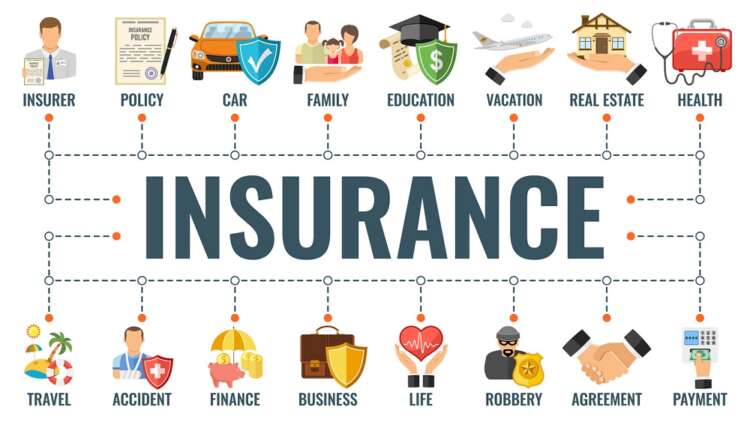
Insurance is a vital tool that provides financial protection and peace of mind in the face of unforeseen events or risks. There are various types of insurance policies available, each serving a specific purpose and covering different aspects of our lives. Understanding these insurance policies is essential to make informed decisions and ensure adequate protection for ourselves, our loved ones, and our assets.
In this guide, we will explore and explain the different types of insurance policies, shedding light on their features, benefits, and the areas they safeguard. Whether you are seeking coverage for your health, property, business, or any other aspect of your life, this comprehensive overview will help you navigate the insurance landscape and make informed choices to protect what matters most to you.
Life Insurance As One of Insurance Policies
Life insurance is a type of insurance policy that provides financial protection to the insured person’s beneficiaries in the event of their death. It offers a way to ensure that loved ones are financially secure and can maintain their standard of living even after the insured person is no longer there to provide for them.
The primary purpose of life insurance is to provide a death benefit to the beneficiaries upon the death of the insured person. This benefit is typically paid out as a lump sum amount, although some policies may offer the option for periodic payments or other payout structures.
6 BEST FOOTBALL SCHOLARSHIP IN EUROPE 2023/2024 APPLY NOW
Life insurance policies are designed to cater to different needs and preferences. There are various types of life insurance policies available, including term life insurance, whole life insurance, universal life insurance, and variable life insurance.
- Term Life Insurance: This type of life insurance provides coverage for a specific term, such as 10, 20, or 30 years. It offers a death benefit if the insured person passes away within the policy term. Term life insurance policies do not accumulate cash value and are generally more affordable compared to other types of life insurance.
- Whole Life Insurance: Whole life insurance is a permanent life insurance policy that provides coverage for the entire lifetime of the insured person. It offers a death benefit as well as a cash value component that grows over time. Premiums for whole life insurance are typically higher than those for term life insurance, but the policy provides lifelong protection and the cash value can be accessed during the insured person’s lifetime.
- Universal Life Insurance: Universal life insurance is another type of permanent life insurance that combines a death benefit with a cash value component. It offers flexibility in premium payments and death benefit amounts. The cash value of a universal life insurance policy earns interest, and policyholders can adjust their premiums and death benefit as their financial needs change.
- Variable Life Insurance: Variable life insurance allows policyholders to allocate their premiums into investment accounts, such as stocks, bonds, or mutual funds. The cash value and death benefit of the policy depend on the performance of these investment accounts. Variable life insurance offers the potential for higher returns but also carries investment risks.
When considering life insurance, it’s important to assess your financial needs, including the amount of coverage you require, your budget, and your long-term goals. Consulting with an insurance professional can help you determine the most suitable life insurance policy for your specific circumstances.

Health Insurance As One of Insurance Policies
Health insurance is a type of insurance coverage that helps individuals and families manage the costs of medical expenses. It provides financial protection by paying for a portion or all of the medical bills and healthcare services covered under the policy. Health insurance offers peace of mind and ensures that individuals can access necessary medical care without facing excessive financial burdens.
There are different types of health insurance plans available, including:
- Employer-Sponsored Health Insurance: Many employers offer health insurance coverage to their employees as part of their benefits package. These plans are often provided through group policies, where the employer negotiates rates and coverage with insurance providers. The cost of the premiums may be shared between the employer and the employee.
- Individual Health Insurance: Individuals who are self-employed or do not have access to employer-sponsored health insurance can purchase individual health insurance plans directly from insurance providers. These plans offer coverage for the individual or their family members, and the premiums are paid by the policyholder.
- Government-Sponsored Health Insurance: Governments may provide health insurance programs to specific populations, such as low-income individuals or senior citizens. Examples of government-sponsored health insurance programs include Medicaid in the United States and the National Health Service (NHS) in the United Kingdom.
- Medicare: Medicare is a federal health insurance program in the United States that primarily serves individuals aged 65 and older. It also provides coverage for certain younger individuals with disabilities. Medicare consists of different parts, including Part A (hospital insurance), Part B (medical insurance), Part C (Medicare Advantage plans), and Part D (prescription drug coverage).
- Medicaid: Medicaid is a joint federal and state program in the United States that provides health coverage for low-income individuals and families. Eligibility for Medicaid is based on income and other factors, and the program is administered by states, following federal guidelines.
Health insurance policies typically cover a wide range of medical services, including hospital stays, doctor visits, prescription medications, preventive care, and more. The coverage and benefits vary depending on the specific plan and insurance provider.
Auto Insurance
Auto insurance, also known as car insurance or motor insurance, is a type of insurance coverage that provides financial protection against damages or losses resulting from car accidents, theft, or other incidents involving a motor vehicle. It is a legal requirement in many countries and jurisdictions to have auto insurance before driving a vehicle on public roads.
Auto insurance policies typically consist of different types of coverage, which may include:
- Liability Coverage: This coverage helps pay for injuries or damages to other people or their property if you are at fault in an accident. It includes bodily injury liability, which covers medical expenses and lost wages of injured parties, and property damage liability, which covers repairs or replacement of damaged property.
- Collision Coverage: This coverage helps pay for damages to your own vehicle resulting from a collision with another vehicle or object, regardless of who is at fault. It usually requires the payment of a deductible before the insurance company covers the remaining costs.
- Comprehensive Coverage: This coverage helps pay for damages to your vehicle caused by non-collision events, such as theft, vandalism, fire, natural disasters, or falling objects. Like collision coverage, it usually requires the payment of a deductible.
- Personal Injury Protection (PIP): PIP coverage, also known as no-fault insurance, provides benefits for medical expenses, lost wages, and other related costs resulting from injuries sustained in an auto accident, regardless of who is at fault.
- Uninsured/Underinsured Motorist Coverage: This coverage protects you if you are involved in an accident with a driver who either does not have insurance or has insufficient coverage to pay for damages or injuries.
The cost of auto insurance premiums is determined by various factors, including the driver’s age, driving record, location, type of vehicle, and coverage limits. Insurance companies assess the risk associated with insuring a particular driver and vehicle, and the premiums are set accordingly.
CHEAP UNIVERSITIES IN SCOTLAND FOR INTERNATIONAL STUDENTS FOR 2023/24 ACADEMIC SESSION
When purchasing auto insurance, it’s important to compare quotes from different insurance providers and understand the coverage options and policy terms. It’s also advisable to review the policy periodically to ensure it meets your changing needs and to consider any additional coverage or discounts that may be available to you.
Homeowners Insurance
Homeowners insurance is a crucial form of protection for homeowners, providing coverage for their property, personal belongings, and potential liability risks. Here is a comprehensive overview of homeowners insurance and its key components:
- Dwelling Coverage: This aspect of homeowners insurance protects the physical structure of your home, including the walls, roof, floors, and built-in appliances. It covers damages caused by perils such as fire, windstorms, hail, lightning, and certain types of water damage. The coverage amount should be based on the estimated cost to rebuild or repair your home in the event of a covered loss.
- Personal Property Coverage: This coverage extends to your personal belongings within the insured property, such as furniture, clothing, electronics, and appliances. It provides financial protection against theft, damage, or destruction caused by covered perils. It’s important to document your possessions and evaluate their value to ensure you have sufficient coverage to replace them if necessary.
- Liability Coverage: Homeowners insurance includes liability coverage, which protects you in the event that someone is injured on your property or you accidentally cause damage to someone else’s property. It covers medical expenses, legal fees, and potential settlements or judgments resulting from liability claims. This coverage helps safeguard your assets and provides financial support in case of lawsuits or liability claims.
- Additional Living Expenses (ALE): If your home becomes uninhabitable due to a covered loss, ALE coverage helps cover additional living expenses while your home is being repaired or rebuilt. This can include costs for temporary housing, meals, storage, and other necessary expenses. ALE coverage ensures that you can maintain your standard of living during the restoration process.
- Deductibles: Homeowners insurance policies typically include a deductible, which is the amount you must pay out of pocket before the insurance coverage comes into effect. The deductible can be a fixed amount or a percentage of the insured value of the home. Choosing a higher deductible can help lower your premium, but it also means you will have a greater financial responsibility in the event of a claim.
- Endorsements and Riders: Homeowners insurance policies may offer additional endorsements or riders that provide coverage for specific risks or valuable items not adequately covered under the standard policy. Examples include coverage for high-value jewelry, artwork, or additional liability coverage for certain activities.
It’s important to carefully review and understand your homeowners insurance policy, including the terms, conditions, and exclusions. Assess your specific needs, property value, and potential risks to ensure you have appropriate coverage. Regularly review and update your policy as needed, particularly when making significant changes to your home or acquiring valuable items.
Conclusion
In conclusion, understanding the various types of insurance policies is crucial for individuals and businesses alike. Each type of insurance serves a specific purpose and provides protection against different risks and uncertainties.
Whether it’s safeguarding your health, property, vehicle, or business, having the right insurance coverage can provide financial security and peace of mind. By familiarizing yourself with the intricacies of insurance policies, you can make informed decisions tailored to your specific needs and circumstances. Remember to assess your risks, consult with insurance professionals, and carefully evaluate the terms and conditions of each policy before making a choice. With the right insurance coverage in place, you can mitigate potential losses and protect what matters most to you in the face of life’s uncertainties.






